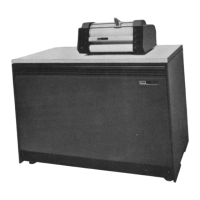of
the
decimal
are
handled
in
the
same
manner
as numbers converted
by
I-type
conversion; one space is always reserved as a sign position.
Included
in
the
count, w, must
be
a space for
the
decimal
point
and
a space
for
the
sign.
The
following examples show
how
each
of
the
quantities on
the
left is
printed
according to
the
specification F7.3.
Value
28.601
-6.4
-.8
4.721
2.48721
Printed
as
b28.601
b-6.400
bb-.800
bb4.721
bb2.487
The
last item is inaccurate because
the
specification
did
not
provide enough
spaces.
The
F -type format is a convenient
way
of expressing
the
results of your
computations,
but
it
has one small pitfall. You
must
have some knowledge of
the
magnitude
of
the
numbers you
are
working with.
The
magnitude
of
the
number
must
not
be
so
great
that
the size of
number
(the
mantissa
and
as
many
decimal places as specified
by
the exponent) is
not
larger
than
the
number
of
places reserved for
it
by
your specification statement.
For
example, consider
the
floating
point
number
in storage
M E
12345678 14
with
the
FORMAT
of F10.3
(which
was assumed to
be
large
enough
for this value
and
any
other
value
in
the
series).
The
size of this
number
would
be
12345678000000.
which, of course, is greater
than
the
10 places reserved for it.
If
this
type
of
error
is
made,
the
FORTRAN
program disregards
the
format
that
is specified,
and
instead prints
the
number
as though its
FORMAT
was E14.8
b.12345678E
+ 14
and
a message is
typed
on
the
typewriter
which
indicates
that
a floating
point
nnmber
is
not
in
the
allowable range of values.
The
same
value
could have
been
obtained
if
the
specification
had
been
written E14.8 (floating
point
with exponent
form).
Of
course you
will
get
the
right
answer
in
this case,
but
the
point
is,
that
if you
are
not
certain of
the
magnitude
of
your
numbers, program your
problem
so
that
your
answers will
be
printed
(or
punched)
in
floating
point
mode
with
an
exponent
(E
con-
version).
E Conversion.
For
E-type
conversion,
the
d
part
of
the
format again specifies
the
number
of digits to
be
retained
to
the
right
of
the
decimal.
Included
in
the
count, w,
must
be
spaces for
the
sign
and
decimal point, plus four spaces for
the
exponent.
In
1620
FORTRAN,
the
object program will
try
to place as
many
significant
digits to
the
left of
the
decimal
as
is possible
by
using
the
specification pro-
vided.
Depending
upon
the
size of
the
mantissa, zeros
may
be
added
to
the
right
of
the
number.
The
position of
the
decimal
point
may
be
moved,
and
if
it
is,
the
Writing
the
1620
FORTRAN
Program 39

